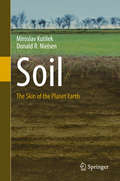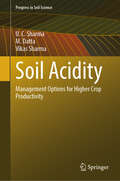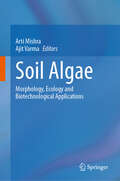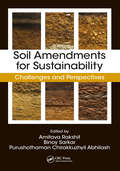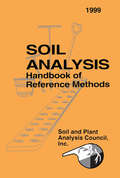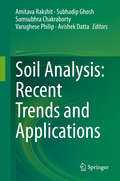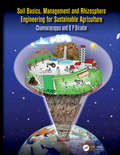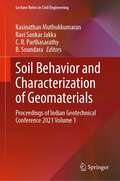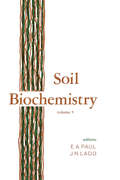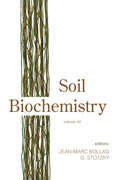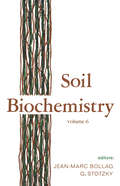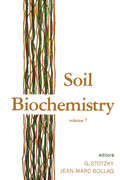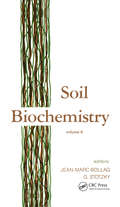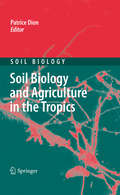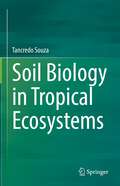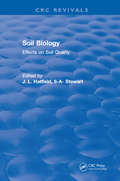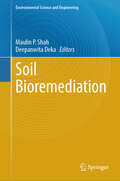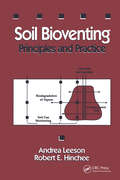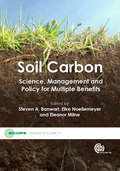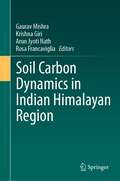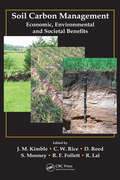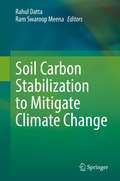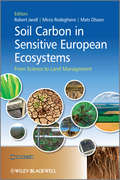- Table View
- List View
Softwareentwicklung von Telematikdiensten
by Grit Behrens Volker Kuz Ralph BehrensDas Buch vermittelt einen Einstieg in die Software-Entwicklung von Telematikdiensten mit einem Eclipse-Plugin für das Common Service Framework (Open Source). Ziel ist es, Nutzer dazu zu befähigen, internetbasierte Telematikdienste selbst zu programmieren. Begleitend zum Buch steht ein Internetportal bereit, wo Beispielapplikationen demonstriert, getestet oder weiter entwickelt werden können. Es gibt des Weiteren Einblick in die Hintergründe und die weltweiten Zukunftsentwicklungen auf dem rasant anwachsenden Gebiet der Telematikdienste.
Soil
by Miroslav Kutílek Donald R. NielsenThe main focus of this monograph is to explain the important role of soil and the environment to a broad audience. Soil is one of the five essential factors crucial for human life. On the one hand the authors describe a responsible approach and use of soil, established on a basic knowledge of the nature of soil and the countless ongoing processes within soil. On the other hand they explain the precarious link between soil and regional environment, which is indispensable for plant and animal communities. In addition to these topics its chapters describe the unique roles of soil texture, soil structure and soil pore systems in hydrologic cycles, plant nutrition and conditions affecting the preservation or eventual extinction of soil. This book concludes with the principles of soil protection and revitalization. General readers with an interest in biology, chemistry, physics or geology will find this book highly informative.
Soil Acidity: Management Options for Higher Crop Productivity (Progress in Soil Science)
by Vikas Sharma U. C. Sharma M. DattaThe book on acid soils offers a thorough analysis of the degree of soil acidity at the global level, information on the biota, chemistry, and behaviour of acid soils, as well as the mechanisms by which plants tolerate soil acidity. It also offers crop management strategies that make effective use of amendments and acid soil-specific crop management practices. Crop output, forest health, and aquatic life all suffer from acidic soil. The main causes are the toxicity of aluminium (Al) and/or manganese (Mn), as well as the deficiencies of calcium (Ca), magnesium (Mg), phosphorus (P), and molybdenum (Mo), to a lesser extent. Lack of calcium affects the health and integrity of cells, which lowers agricultural yield and quality. To achieve the highest crop productivity, management options have been provided. All concerned will find this book of great assistance in solving the global food crisis in a sustainable manner.
Soil Algae: Morphology, Ecology and Biotechnological Applications
by Ajit Varma Arti MishraThis book collates updated knowledge about algal species which are present in the terrestrial environment particularly in soil. Contributions in this volume covers different topics such as morphology, ecology and applications of soil algae. Ecological significance of soil algae and their biotechnological importance are the key features of this book. Algae are ubiquitous and occur in almost all terrestrial environments and in soil, they majorly belong to the member of Chlorophycophyta, Cyanochloronta, Rhodophycophyta Euglenophycophyta, and Chrysophycophyta. The role of soil algae as fertilizer and for reclaiming the saline soil is well studied. Algae in soil benefits agricultural production, increase water retention capacity, reduced soil erosion, reduction of nutrient runoff, and provides nutrients. The added algae increase soil biodiversity, organic biomass, and the total humus content of the soil, beneficial for healthy soil. These soil algae diversities also have many biotechnological and industrial importance. This book is of interest and use to researchers of phycology, molecular biology, agriculture and biotechnology and also to scientists working on soil biology, agronomy and crop research. Also, the book serves as reading material for undergraduate and graduate students of microbiology, agriculture, molecular biology, and biotechnology. Researchers from biotechnological and biofertilizers companies will also find this to be a useful read.
Soil Amendments for Sustainability: Challenges and Perspectives
by Amitava Rakshit Binoy Sarkar Purushothaman AbhilashThis book focuses on the pros and cons of amendment materials to restore the functioning of soil resources. It presents a holistic overview on affected land revitalization, clean up and revegetation using these amendments that could be implemented in the long term management of the soil-plant-atmosphereanimal continuum.
Soil Analysis Handbook of Reference Methods
by Soil and Soil and Plant Analysis Council Inc.For more than 30 years, soil testing has been widely used as a basis for determining lime and fertilizer needs. Today, a number of procedures are used for determining everything from soil pH and lime requirement, to the level of extractable nutrient elements. And as the number of cropped fields being tested increases, more and more farmers and growers will come to rely on soil test results. But if soil testing is to be an effective means of evaluating the fertility status of soils, standardization of methodology is essential. No single test is appropriate for all soils.Soil Analysis Handbook of Reference Methods is a standard laboratory technique manual for the most commonly used soil analysis procedures. First published in 1974, this Handbook has changed over the years to reflect evolving needs. New test methods and modifications have been added, as well as new sections on nitrate, heavy metals, and quality assurance plans for agricultural testing laboratories. Compiled by the Soil and Plant Analysis Council, this latest edition of Soil Analysis Handbook of Reference Methods also addresses the major methods for managing plant nutrition currently in use in the United States and other parts of the world. For soil scientists, farmers, growers, or anyone with an interest in the environment, this reference will prove an invaluable guide to standard methods for soil testing well into the future.Features
Soil Analysis in Forensic Taphonomy: Chemical and Biological Effects of Buried Human Remains
by Mark Tibbett David O. CarterA burial environment is a complex and dynamic system. It plays host to an abundance of interdependent chemical, physical, and biological processes, which are greatly influenced by the inclusion of a body and its subsequent decay. However, while taphonomy continues to emerge as a valuable forensic tool, until now most of the attention has been on th
Soil Analysis: Recent Trends and Applications
by Amitava Rakshit Subhadip Ghosh Somsubhra Chakraborty Varughese Philip Avishek DattaSoil analysis is critically important in the management of soil-based production systems. In the absence of efficient methods of soil analysis our understanding of soil is pure guesswork. Ideally the pro-active use of laboratory analysis leads to more sustainable soil productivity. Unfortunately, most of the world’s agriculture is still reactionary, waiting for obvious yield declines to occur before taking action to identify the reasons. The modern soil laboratory is pivotal to informing soil managers what adaptive practices are needed to address chemical and physical imbalances before they occur, and the intelligent adaptive use of laboratory data not only greatly speeds up and reduces the cost of empirical soil study, but can even render it unnecessary. This book provides a synopsis of the analytical procedures used for soil analysis, discussing the common physical, chemical and biological analytical methods used in agriculture and horticulture. Written by experienced experts from institutions and laboratories around the globe, it provides insights for a range of users, including those with limited laboratory facilities, and helps students, teachers, soil scientists and laboratory technicians increase their knowledge and skills and select appropriate methods for soil analysis.
Soil Basics, Management and Rhizosphere Engineering for Sustainable Agriculture
by Channarayappa C. D P BiradarIncrease in global population, drastic changes in the environment, soil degradation and decrease in quality and quantity of agricultural productivity warranted us to adapt sustainable farming practices. This book focuses on soil health management and creating biased rhizosphere that can effectively augment the needs of sustainable agriculture.
Soil Behavior and Characterization of Geomaterials: Proceedings of Indian Geotechnical Conference 2021 Volume 1 (Lecture Notes in Civil Engineering #296)
by C. R. Parthasarathy Kasinathan Muthukkumaran Ravi Sankar Jakka B. SoundaraThis book comprises the select peer-reviewed proceedings of the Indian Geotechnical Conference (IGC) 2021. The contents focus on Geotechnics for Infrastructure Development and Innovative Applications. The book covers topics related to soil behavior and characterization of geomaterials, geotechnical, geological, and geophysical investigation of special topics such as behavior of unsaturated soils, offshore and marine geotechnics, remote sensing and GIS, instrumentation and monitoring, retrofitting of geotechnical structures, reliability in geotechnical engineering, geotechnical education, codes and standards, among others. This volume will be of interest to those in academia and industry.
Soil Biochemistry
by E. A. Paul J.N. LaddThis book reviews some aspects of soil biochemistry, including the biochemical turnover of specific elements and organic compounds in soil; the properties and functions of soil enzymes; and the structure, distribution and pathways of metabolism of organic compounds.
Soil Biochemistry, Volume 10 (Books in Soils, Plants, and the Environment)
by Jean-Marc Bollag G. Stotzky Dejan PlavsicAn exploration of the most complex microbial ecosystems with incisive reviews of developments in soil science. It presents techniques of chemical analysis, refinements of environmental protection measures, and methods for maximizing agricultural yields. It also addresses a wide range of biochemical processes and practical applications of advanced b
Soil Biochemistry: Volume 6: Volume 6 (Books In Soils, Plants, And The Environment Ser. #15)
by J.-M. BollagExplores the role of biochemical processes in the soil environment, particularly the activity of microorganisms, and the potential application of those processes to environmental biotechnology. The 11 papers also highlight the application of molecular biology and microbial genetics to soil biology a
Soil Biochemistry: Volume 7
by Jean-Marc Bollag G. StotzkyThis book describes the interactions between soil minerals and microorganisms to more specialized areas such as the formation of desert varnishes. It is helpful for scientists and students who want to extend their knowledge of and research into soil biochemistry.
Soil Biochemistry: Volume 8
by Jean-Marc Bollag G. StotzkyStressing the potential application of biochemical processes in soil to environmental biotechnology, this state-of-the-art reference considers the vital role that such biochemical processes have in the environment - emphasizing the activity of micro-organisms in soil.;An up-to-date analysis of biological reactions in soil, Volume 8 of Soil Biochemistry highlights: traditional as well as molecular and immunlogical techniques for detecting specific micro-organisms in soil; the fate of introduced genetically-modified organisms; the problem of competition by the indigenous microbial populations with the introduced organisms; the use of a white rot fungus, Phanerochaete chrysosporium, for bioremediative purposes in soil; the interaction of xenobiotics, such as pesticides, with soil organisms; generic microbial metabolism and degradation pathways; the inhibition of the nitrification process by allelochemicals released by plants; the microbial mineralization of various compounds under anaerobic conditions, explaining its importance in the global carbon cycle; the formation of soil organic matter, particularly in forest soils; and CPMAS 13C-NMR spectroscopy, a major analytical technique to determine the chemicals or chemical groups involved in the humification process.;Presenting a multidisciplinary approach to the field by internationally acclaimed scientists, Soil Biochemistry, Volume 8 is intended for professionals and students in the fields of soil science; microbiology; biochemistry; environmental science, engineering and technology; biogeochemistry; biotechnology; agronomy; plant pathology; and microbial ecology.
Soil Biology and Agriculture in the Tropics
by Patrice DionThe relationships between soils, microbes and humans are of crucial relevance in the tropics, where plant stress and microbial activity are exacerbated. This volume of Soil Biology presents the living component of tropical soils, showing how it is shaped by environmental conditions and emphasizing its dramatic impact on human survival and well-being. Following an introduction to the specificities of tropical soils and of their microbial communities, the biological aspects of soil management are examined, dealing with land use change, conservation and slash-and-burn agriculture, the restoration of hot deserts, agroforestry and paddy rice cultivation. As they are of particular relevance for tropical agriculture, symbioses of plants and microbes are thoroughly covered, as are the biodegradation of pesticides and health risks associated with wastewater irrigation. Lastly, traditional soil knowledge is discussed as a key to our sustainable presence in this world.
Soil Biology in Tropical Ecosystems
by Tancredo SouzaThis textbook explores the complex nature of soil biological communities and their environments, and covers deserts, rainforests, seasonal tropical forests, dry deciduous forests, and island environments in the tropical zone. It provides essential information on soil biology concepts, ecological processes, plant-soil feedback, trophic structure, and land use effects on soil’s biological properties. The book also offers an updated approach to soil biota and microbiota and their interactions with plants that regulate the structures and functions of tropical ecosystems. Uniquely, it addresses island environments and natural disasters, shedding new light on soil organisms recovering tropical ecosystem functions. Further topics include ecological processes, plant-soil interactions, trophic communities, molecular approaches, and land use, making the book a valuable asset for students, educators and researchers engaged in the Environmental Sciences, Biodiversity and Conservation, Soil Ecology, Soil Biology, Ecology, Zoology, and Soil Biota Classification using classical and molecular tools.
Soil Biology: Effects on Soil Quality (Advances In Soil Science Ser.)
by J. L. HatfieldSoil Biology is a state-of-the art review focusing on the linkage between biological processes that occur in the soil and their impact on soil quality. Topics considered include the microbial ecology of conservation management systems, dynamic processes of vesicular-arbuscular mycorrhizae, earthworms and soil fauna, microbial processes in the soil, and the degradation of pesticides through microbial processes. The book will interest soil scientists, microbiologists, agronomists, and soil ecologists.
Soil Bioremediation (Environmental Science and Engineering)
by Maulin P. Shah Deepanwita DekaThis book is presented on bioremediation of soil including different aspects for sustainable development of agriculture, environment etc. Significant attention is being paid to plants and microbes because of their metabolomics, molecular mechanisms, biochemical pathways, bioengineering, and cost-effective nature in an eco-friendly green approach. It presents a detailed account on phytoremediation, microbial remediation; application of different plants and microorganisms for bioremediation in agricultural soil; nanoparticles, metabolites produced by plants and microbes for bioremediation of soil; multidisciplinary approaches of bioremediation to alleviate major soil contamination issues, molecular mechanisms, biochemical approach of bioremediation of soil; plants and microbial engineering for bioremediation; recent advances and challenges; future prospects of bioremediation of contaminated soil, utilizing biodiversity for sustainable development of the soil ecosystem.
Soil Bioventing: Principles and Practice
by Andrea Leeson Robert E. HincheeSoil bioventing is one of the most popular modern techniques for removing contaminants from soil. It has recently emerged as one of the most cost-effective and efficient technologies available for vadose zone remediation of petroleum-contaminated sites. This book explains in practical terms how to carry out a bioventing program. It is an interdisciplinary treatment of the subject, covering everything from basic physical and chemical properties of soils to site evaluation, project design, and post-bioventing monitoring.The wide breadth of coverage makes Soil Bioventing useful to a large audience, including consulting firms, students, contractors, environmental managers, and anyone who is responsible for supervision of soil cleanup for regulatory reasons.
Soil Carbon
by Meine Van Noordwijk Pete Smith Christiano Ballabio Daniel Buschiazzo Elke Noellemeyer Steven A Banwart Bas Van Wesemael Genxing Pan Francesca Bampa Rich Conant Heitor L.C. Coutinho Patrick Gicheru Andre Bationo Roger Funk David Werner Martial Bernoux Unai Pascual Tapas Bhattacharyya Marty Goldhaber Hans Joosten Dave Abson Niels Batjes Carlos Eduardo Cerri Generose Nziguheba David Powlson Christian Feller Pierre-Alain Maron Luca Montanarella Yongcun Zhao Chris Duffy Eleanor MilneThis book brings together the essential evidence and policy opportunities regarding the global importance of soil carbon for sustaining Earth's life support system for humanity. Covering the science and policy background for this important natural resource, it describes land management options that improve soil carbon status and therefore increase the benefits that humans derive from the environment. Written by renowned global experts, it is the principal output from a SCOPE rapid assessment process project. Read a chapter for free
Soil Carbon Dynamics in Indian Himalayan Region
by Rosa Francaviglia Arun Jyoti Nath Gaurav Mishra Krishna GiriThe contributed volume assimilates the knowledge, experience, and exciting aspects of soil carbon research in the Indian Himalayan region. It includes different aspects and factors associated with soil carbon sequestration in the region, one of the biodiversity hot spots and highly vulnerable to climatic change impacts. Information on different aspects of soil organic carbon dynamics concerning adaptive land management practices and anthropogenic impacts is covered. Further topics include applying advanced tools and techniques to soil carbon vis-a-vis soil erosion research. This book is of interest to researchers and policymakers involved in soil carbon research and offer ideas to enhance the soil carbon in the region concerned. In addition, the book will provide up-to-date information for researchers interested in soil carbon research for the maintenance of soil quality and fertility in the climate-vulnerable Indian Himalayan region.
Soil Carbon Management: Economic, Environmental and Societal Benefits
by R. Lal J. M. Kimble C. W. Rice D. Reed S. Mooney R. F. FollettBetter Manage Soil C for Improved Soil Quality In the United States, soil has fueled the availability of abundant, safe food, thus underpinning economic growth and development. In the future we need to be more vigilant in managing and renewing this precious resource by replacing the nutrients and life-sustaining matter that we remove for
Soil Carbon Stabilization to Mitigate Climate Change
by Ram Swaroop Meena Rahul DattaCarbon stabilization involves to capturing carbon from the atmosphere and fix it in the forms soil organic carbon stock for a long period of time, it will be present to escape as a greenhouse gas in the form of carbon dioxide. Soil carbon storage is an important ecosystem service, resulting from interactions of several ecological processes. This process is primarily mediated by plants through photosynthesis, with carbon stored in the form of soil organic carbon. Soil carbon levels have reduced over decades of conversion of pristine ecosystems into agriculture landscape, which now offers the opportunity to store carbon from air into the soil. Carbon stabilization into the agricultural soils is a novel approach of research and offers promising reduction in the atmospheric carbon dioxide levels. This book brings together all aspects of soil carbon sequestration and stabilization, with a special focus on diversity of microorganisms and management practices of soil in agricultural systems. It discusses the role of ecosystem functioning, recent and future prospects, soil microbial ecological studies, rhizosphere microflora, and organic matter in soil carbon stabilization. It also explores carbon transformation in soil, biological management and its genetics, microbial transformation of soil carbon, plant growth promoting rhizobacteria (PGPRs), and their role in sustainable agriculture. The book offers a spectrum of ideas of new technological inventions and fundamentals of soil sustainability. It will be suitable for teachers, researchers, and policymakers, undergraduate and graduate students of soil science, soil microbiology, agronomy, ecology, and environmental sciences
Soil Carbon in Sensitive European Ecosystems
by Mats Olsson Robert Jandl Mirco RodeghieroSoil Carbon in Sensitive European Ecosystems - From Science to Land Management is a comprehensive overview of the latest research in this field drawn together by a network of scientists from across Europe. Soil carbon assessments are crucial at present to our understanding of the dynamics of terrestrial ecosystems and our ability to assess implications for the global carbon exchange and its consequences on the future climate. This book focuses primarily on ecosystems and their soil carbon stocks. The book identifies three key sensitive ecosystems within Europe: Mediterranean Forest and Agricultural Systems; Mountains; and Peatland.Contributors include those currently working for the European research programme, COST Action 639 BurnOut (www.cost639.net; 2006-2010).COST Action 639 emerged from a demand from policy makers in Europe for more detailed information on soil carbon dynamics. The cooperation between experts for reporting and experts for soil dynamics is the focus of the book. This book seeks to provide an up-to-date account on the state-of-the-art research within this topical field.

